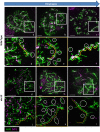Observation of Extensive Chromosome Axis Remodeling during the "Diffuse-Phase" of Meiosis in Large Genome Cereals
- PMID: 28751906
- PMCID: PMC5508023
- DOI: 10.3389/fpls.2017.01235
Observation of Extensive Chromosome Axis Remodeling during the "Diffuse-Phase" of Meiosis in Large Genome Cereals
Abstract
The production of balanced fertile haploid gametes requires the faithful separation of paired (synapsed) chromosomes toward the end of meiotic prophase I (desynapsis). This involves the timely dissolution of the synaptonemal complex during the pachytene-diplotene transition, a stage traditionally referred to as the "diffuse stage." In species with large genomes such as, barley (Hordeum vulgare L.) and wheat (Triticum aestivum L.) we know most about the early stages of meiotic prophase I. There, synapsis initiates at the telomeric ends of chromosomes and progresses toward the centromeric regions through the ordered assembly of the synaptonemal complex (SC). Synapsis is impacted by recombination (crossing over, CO) which locally modifies the extent of chromatin compaction and extension. CO is uneven along the chromosomes, occurring mainly toward the telomeric regions resulting in a highly skewed distribution of recombination events. However, we know very little about the process of desynapsis which occurs during the "diffuse stage," where the synapsed and recombined chromosomes faithfully desynapse and separate into daughter cells. Here, using 3D-SIM super-resolution immuno-cytology combined with the use of antibodies directed against two crucial SC proteins, ASY1 and ZYP1, we followed the whole of meiosis I (i.e., both synapsis and desynapsis) in both barley and wheat. We showed that synapsis forms a characteristic tri-partite SC structure in zygotene (more clearly seen in barley). Toward the end of meiosis I, as the SC starts to disassemble, we show that extensive chromosome axis remodeling results in the formation of characteristic "tinsel-like" structures in both wheat and barley. By using a mutant (des10) that is severely compromised in polymerization of ZYP1during synapsis, we show that tinsel structure formation during SC dissolution is not dependant on full synapsis and may relate instead to changes in expansion stress. Our observations highlight a potentially new role for ASYNAPSIS1 (ASY1) in desynapsis, in addition to chromosome synapsis and cohesion.
Keywords: ASY1; cereal; chromatin; meiosis; synapsis.
Figures




Similar articles
-
Ultrastructure and Dynamics of Synaptonemal Complex Components During Meiotic Pairing and Synapsis of Standard (A) and Accessory (B) Rye Chromosomes.Front Plant Sci. 2019 Jun 20;10:773. doi: 10.3389/fpls.2019.00773. eCollection 2019. Front Plant Sci. 2019. PMID: 31281324 Free PMC article.
-
CENH3 morphogenesis reveals dynamic centromere associations during synaptonemal complex formation and the progression through male meiosis in hexaploid wheat.Plant J. 2017 Jan;89(2):235-249. doi: 10.1111/tpj.13379. Epub 2017 Jan 17. Plant J. 2017. PMID: 27624968
-
High resolution analysis of meiotic chromosome structure and behaviour in barley (Hordeum vulgare L.).PLoS One. 2012;7(6):e39539. doi: 10.1371/journal.pone.0039539. Epub 2012 Jun 25. PLoS One. 2012. PMID: 22761818 Free PMC article.
-
[Cytogenetic patterns in synapsis of meiotic chromosomes in animals and plants].Genetika. 1996 Nov;32(11):1474-93. Genetika. 1996. PMID: 9119209 Review. Russian.
-
Chromatin structure contribution to the synaptonemal complex formation.Cell Mol Life Sci. 2009 Apr;66(7):1198-208. doi: 10.1007/s00018-008-8584-2. Cell Mol Life Sci. 2009. PMID: 19099188 Free PMC article. Review.
Cited by
-
Core spliceosomal Sm proteins as constituents of cytoplasmic mRNPs in plants.Plant J. 2020 Aug;103(3):1155-1173. doi: 10.1111/tpj.14792. Epub 2020 May 28. Plant J. 2020. PMID: 32369637 Free PMC article.
-
Chromosome-nuclear envelope tethering - a process that orchestrates homologue pairing during plant meiosis?J Cell Sci. 2020 Aug 12;133(15):jcs243667. doi: 10.1242/jcs.243667. J Cell Sci. 2020. PMID: 32788229 Free PMC article. Review.
-
Tackling Plant Meiosis: From Model Research to Crop Improvement.Front Plant Sci. 2018 Jun 19;9:829. doi: 10.3389/fpls.2018.00829. eCollection 2018. Front Plant Sci. 2018. PMID: 29971082 Free PMC article. Review.
-
Ultrastructure and Dynamics of Synaptonemal Complex Components During Meiotic Pairing and Synapsis of Standard (A) and Accessory (B) Rye Chromosomes.Front Plant Sci. 2019 Jun 20;10:773. doi: 10.3389/fpls.2019.00773. eCollection 2019. Front Plant Sci. 2019. PMID: 31281324 Free PMC article.
-
From Microscopy to Nanoscopy: Defining an Arabidopsis thaliana Meiotic Atlas at the Nanometer Scale.Front Plant Sci. 2021 May 18;12:672914. doi: 10.3389/fpls.2021.672914. eCollection 2021. Front Plant Sci. 2021. PMID: 34084178 Free PMC article. Review.
References
-
- Bennett M. D. (1984). Premeiotic events and meiotic chromosome pairing. Symp. Soc. Exp. Biol. 38, 87–121. - PubMed
-
- Bennett M. D., Chapman V., Riley R. (1971). Duration of meiosis in pollen mother cells of wheat, rye and triticale. Proc. R. Soc. B Biol. Sci. 178, 259–275. 10.1098/rspb.1971.0065 - DOI
-
- Bennett M. D., Finch R. A. (1971). Duration of meiosis in barley. Genet. Res. 17, 209–214. 10.1017/S0016672300012234 - DOI
Grants and funding
LinkOut - more resources
Full Text Sources
Other Literature Sources

